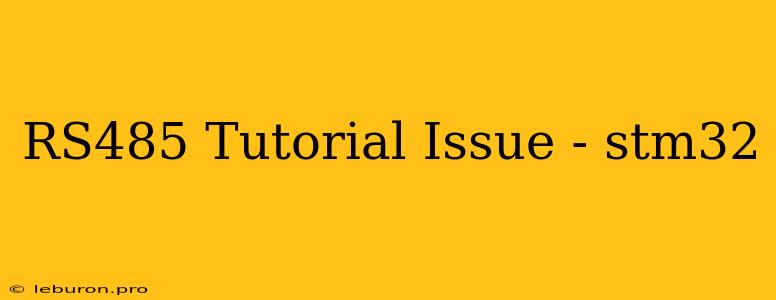The RS485 protocol is a popular choice for industrial communication due to its robustness and long-distance capabilities. Implementing an RS485 communication system with an STM32 microcontroller can be a rewarding project, offering numerous advantages for data transfer over longer distances. However, encountering issues during this process is not uncommon. This tutorial aims to guide you through the common problems encountered while setting up RS485 communication with an STM32 microcontroller, providing solutions and troubleshooting tips.
Understanding RS485 Communication
RS485 is a differential signaling standard that uses two wires (A and B) to transmit data. It employs a balanced line architecture, where data is transmitted as the difference in voltage between these two wires, making it less susceptible to noise and interference compared to single-ended communication systems. This makes it suitable for industrial environments with potentially harsh electromagnetic conditions.
Key Features of RS485:
- Differential Signaling: RS485 uses a differential signal pair, A and B, for data transmission. The data is encoded as the difference in voltage between these two wires, reducing noise susceptibility.
- Multi-drop Bus: Multiple devices can be connected to the same RS485 bus, enabling communication between several nodes.
- Long Transmission Distances: RS485 can achieve longer transmission distances compared to other communication protocols.
- Half-Duplex Operation: RS485 is a half-duplex protocol, meaning that only one device can transmit at a time.
- Termination Resistors: Termination resistors are typically used at the ends of the RS485 bus to prevent signal reflections and improve signal integrity.
Common RS485 Issues with STM32
Here are some common issues faced while implementing RS485 communication with an STM32 microcontroller:
1. Incorrect Wiring:
One of the most common mistakes is incorrect wiring of the RS485 transceiver. The RS485 transceiver is a critical component that converts the single-ended signals from the STM32 into differential signals for transmission on the RS485 bus, and vice versa. If the wiring is incorrect, the data will not be transmitted or received correctly.
- Ensure you connect the appropriate pins: The DE (Data Enable) pin of the transceiver should be connected to a GPIO pin on the STM32, which is used to enable transmission.
- Verify polarity: Ensure the RE (Receiver Enable) and DE (Data Enable) pins are correctly connected to the transceiver.
- Connect the transceiver correctly: Ensure the A and B pins of the transceiver are connected to the appropriate RS485 bus wires.
2. Signal Integrity Issues:
The RS485 signal integrity can be affected by factors like improper termination, long cable lengths, and EMI interference.
- Termination resistors: Ensure that termination resistors are properly connected at the ends of the RS485 bus. They are crucial for damping reflections and improving signal integrity.
- Cable length: Consider the cable length and the maximum allowed distance for RS485 communication. Signal degradation can occur over long distances, affecting communication.
- EMI shielding: Employ EMI shielding techniques, such as using shielded twisted-pair cables and proper grounding, to minimize interference from external electromagnetic fields.
3. Driver Enable Issues:
The driver enable functionality of the RS485 transceiver must be correctly controlled to avoid data collisions on the bus.
- Ensure proper driver enable control: The DE (Data Enable) pin of the transceiver should be asserted only when the STM32 is transmitting data.
- Use a separate GPIO pin for DE: Use a dedicated GPIO pin on the STM32 to control the driver enable.
4. Software Configuration Errors:
The software configuration plays a crucial role in setting up RS485 communication.
- Baud Rate Matching: Ensure that the baud rate settings on the STM32 and other devices on the RS485 bus are identical.
- Parity Bit Configuration: Ensure that the parity bit settings are the same on all devices on the bus.
- Data Format (Start and Stop Bits): Make sure the start and stop bit configurations are correctly set.
5. Device Compatibility:
Ensure that the STM32 and other devices on the RS485 bus are compatible with the RS485 standard.
- Verify compatibility: Check the specifications of the transceivers and other devices to ensure they comply with the RS485 standard.
- Ensure the devices are properly configured: Make sure the devices on the RS485 bus are correctly configured for communication.
Troubleshooting RS485 Issues
Here are some practical troubleshooting tips for RS485 communication with an STM32:
- Check wiring: Carefully inspect the wiring connections to the transceiver and the RS485 bus, ensuring proper polarity and connection.
- Verify signal integrity: Measure the signal levels on the RS485 bus using an oscilloscope. Look for distortions, reflections, or noise that may indicate signal integrity problems.
- Check termination resistors: Verify that the termination resistors are properly connected and that their values are appropriate for the length of the bus.
- Use a logic analyzer: Employ a logic analyzer to capture and analyze the communication signals on the RS485 bus. This can help pinpoint issues related to timing, data corruption, or protocol errors.
- Test with known working devices: Use a known working RS485 device to test communication with the STM32. This can help isolate problems related to the STM32 or its software configuration.
- Check the driver enable: Ensure that the driver enable functionality of the transceiver is working correctly by monitoring the DE (Data Enable) pin on the STM32.
Conclusion
Successfully implementing RS485 communication with an STM32 microcontroller requires careful attention to wiring, signal integrity, driver enable control, and software configuration. By understanding the common issues and troubleshooting tips provided in this article, you can efficiently diagnose and resolve any problems encountered during the setup process. Remember to test the RS485 communication thoroughly before deploying your system in a production environment. With proper care and understanding, you can leverage the benefits of the RS485 protocol to create robust and reliable communication systems for your industrial applications.
